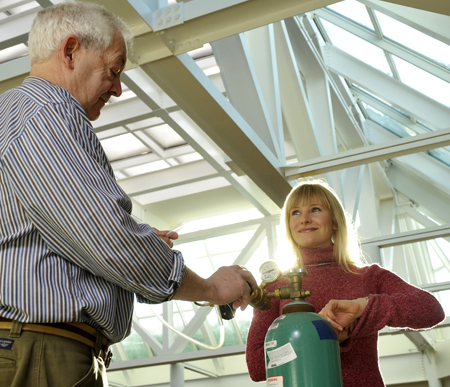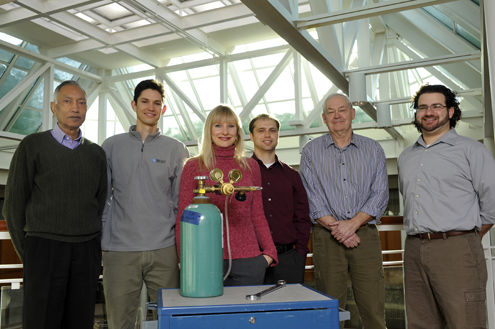Publications
Lab Notes
| SENSING | Posted February 2009 |
Early Warning Chemical Sensors Pass an Indoor Test A relatively cheap sensor system can detect indoor attacks in buildings with chemical weapons. |
|
Metal detectors and X-ray scanners may keep guns and bombs out of sensitive government buildings and military facilities, but they're powerless to stop the spread of airborne chemical weapons. So a team led by Juliette Seeley of Lincoln Laboratory's Sensor Technology and System Applications Group is working to convince people that a relatively simple and inexpensive sensing system can provide early warning of chemical attacks and allow building managers to respond appropriately.
"We're just trying to demonstrate that it's a good sensor that people should be using for indoor sensing," says Seeley, a physical chemist. Her method entails measuring the infrared light passing through a gas to identify its chemical makeup. Such long-wave infrared spectroscopy has been used outdoors by the Environmental Protection Agency (EPA) to monitor chemical plants and refineries for polluting emissions.
 By releasing sulfur hexafluoride gas in the Lincoln Laboratory lobby, Juliette Seeley (shown here with colleague Robert Ashworth) demonstrated that simple sensors could give early warning of chemical releases. By releasing sulfur hexafluoride gas in the Lincoln Laboratory lobby, Juliette Seeley (shown here with colleague Robert Ashworth) demonstrated that simple sensors could give early warning of chemical releases. |
But Seeley's system differs from the EPA's. "If somebody's going to attack you with a chemical weapon, they're going to use a very high concentration," she points out. "So we don't have to be as sensitive and we can use cheaper technologies."
The system relies on an off-the-shelf infrared spectrometer, such as a laboratory might use for characterizing various substances. At the port where a container holding the test sample would normally go, Roshan Aggarwal of the Laser Technology and Applications Group built an optical system to pick up light coming from a source across the room. A collimated infrared beam from a filament travels along a straight line across one part of a room to a mirror, which directs it along another path to a periscope; the use of a periscope allows the positioning of the beam above the heads of people, so passers-by won't interrupt it. The telescope then collects the light and directs it to the spectrometer/detector coupled to a Fourier transform spectrometer. (This arrangement, with the sensor physically separated from a transmitter, is known as a bistatic system.)
The resulting spectrum is used to identify any material that might have absorbed the light along its path, and a computer compares its findings to a library containing the chemical signatures of various materials, including chemical weapons agents. The signatures of all sorts of chemical weapons, such as the nerve agent sarin, blister agents such as mustard gas, as well as chemicals that cause bleeding and choking, are well known and can be stored in the computer. Chemical warfare agents have known signatures in the 8- to 12-micrometer wavelength range in which the system operates. The system is not as sensitive to biological agents, which have less distinctive signatures in that part of the spectrum and absorb less light. The system is also blind to a few toxic industrial chemicals. It's a simple matter, Seeley says, to tell the computer not to raise an alarm when it identifies a relatively benign substance such as that found in cleaning fluids. "We detect it, but we don't accuse it of being a threat," she says. (For details of the sensing system, see the article by Seeley and Jonathan Richardson, "Early Warning Chemical Sensing," Lincoln Laboratory Journal, vol. 17, no. 1, page 85.)
To demonstrate their system, the researchers used Lincoln Laboratory itself as a testbed. Late one Saturday night, when they knew the lab would be nearly empty, they set up the system in the main lobby. As a test material, they used sulfur hexafluoride, an inert gas used to check heating, ventilating, and air-conditioning (HVAC) systems for leaks. The team also rented point sensors that used the same technology (infrared spectroscopy) to detect chemicals, so they could compare the results. The spectrometer system detected every release the point sensors saw, and even picked up on one release that a point sensor missed. Similarly, the spectrometer detected the releases for much longer than did the point sensors, while the point sensors would have declared the area safe long before the area was actually clear.
One worry was that the relatively heavy SF6 might fall to the floor, below the infrared beam. As it turned out, that didn't happen. Seeley says normal air currents or diffusion was enough to stir up the chemical and send it into the path of the beam, even when it was released near the ground. And she points out that a substance that sank to the floor and stayed there would not be a particularly effective weapon anyway.
The other question the researchers wanted to answer was whether detecting the chemical allowed them to respond effectively. "If you can't actually do anything by knowing about the attack, it doesn't help prevent injury," Seeley says.
So the team placed a point sensor in the auditorium on the level beneath the main lobby. They used the HVAC system to pump in extra air, so that air pressure inside the auditorium would be greater than outside. As long as they maintained that positive pressure, they detected no SF6. When they turned off the HVAC, the chemical began to seep in. When they turned it back on, the level of the chemical dropped again. Those results, Seeley says, show that a building manager could provide some protection from a chemical attack through simple manipulation of the HVAC system. Another possibility would be to use the sensors to identify clear and contaminated parts of a building and thus prescribe an evacuation route.
Seeley says the system her team developed can predict how the sensors would respond to an actual chemical attack. The government has data about chemical warfare agents' physical properties, which affect how the substances move through air, and their infrared absorption coefficients. Comparing those to the test data on SF6 allows Seeley and her colleagues to create computer models of the system reacting to other chemicals. Sarin, for instance, is not as easy to detect as SF6, but would still be captured by the sensor, the model predicts.
 The chemical sensing experiment was conducted by (left to right) Roshan Aggarwal, John Aldridge, Juliette Seeley, Joseph Costa, Robert Ashworth, and Ira Mabel.
The chemical sensing experiment was conducted by (left to right) Roshan Aggarwal, John Aldridge, Juliette Seeley, Joseph Costa, Robert Ashworth, and Ira Mabel.There are other types of chemical sensors based on other technologies that can also provide protection. But Seeley emphasizes some of the advantages of the bistatic infrared system. For instance, ion mobility spectrometry, a competing technology, identifies chemicals by measuring how long it takes them to move through an electrical field after ionization; as currently implemented, however, this technique is more susceptible to false positives. Cost is another issue. The point sensors Seeley rented can each cost about the same as her system, but it takes five or six of them to cover a whole room. Maintenance has also been a major obstacle with point sensors. Since the bistatic system is noncontact, the need for maintenance is greatly reduced.
Since completing these tests, Seeley's team has been looking for a company interested in developing the system commercially. Seeley hopes the extra measure of security the system could bring to government and military buildings makes it appealing. "We're trying to bring awareness that this is something useful," she says.
top of page